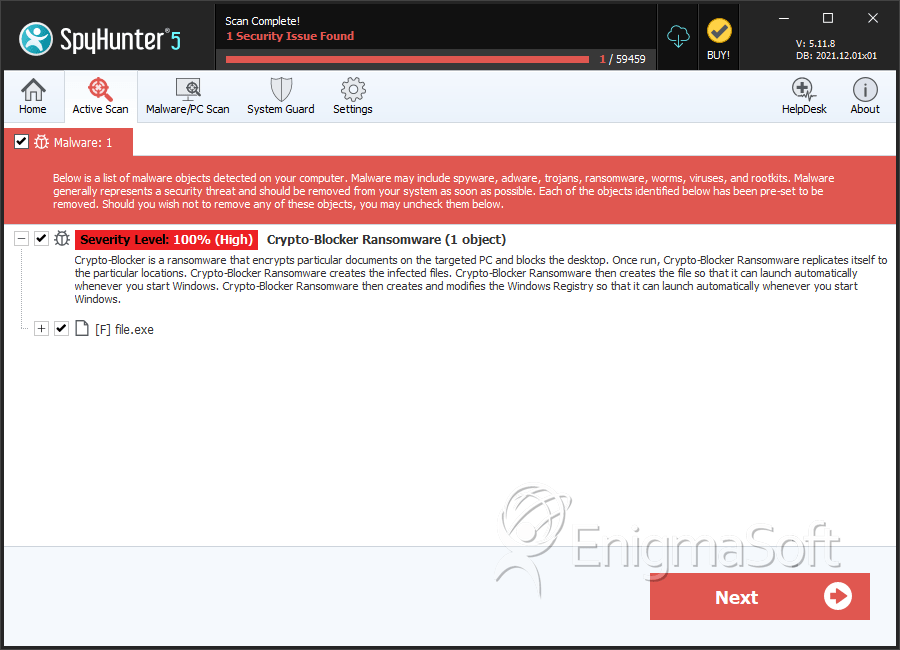Crypto-Blocker Ransomware
The Crypto-Blocker Ransomware is a ransomware Trojan that is used to target computer users that speak English. The Crypto-Blocker Ransomware, like most ransomware Trojans, uses a strong encryption algorithm to make the victim's files inaccessible, essentially holding them ransom until the victim pays for the decryption key needed to access the affected files. There are many methods with which Trojans like the Crypto-Blocker Ransomware can be delivered to victims. The most common method involves spam email attachments, which use corrupted scripts to download and install the Crypto-Blocker Ransomware on the victim's computer. The Crypto-Blocker Ransomware will attack computers running the Windows operating system, up to the latest versions. Current attacks have been spotted in North America and Europe. PC security researchers are investigating the Crypto-Blocker Ransomware, and other ransomware Trojans released recently to find ways to help computer users recover from the attack. One particular aspect of the Crypto-Blocker Ransomware that's unusual is that this threat does not demand a large ransom, asking only for approximate $10 USD (while most ransomware Trojans ask for between $500 and $1500 USD that should be paid in BitCoins.
Table of Contents
How the Crypto-Blocker Ransomware Trojan Works
The Crypto-Blocker Ransomware is nearly identical to most ransomware Trojans being released, carrying out the same basic attack and encrypting the victim's files with a combination of the AES and RSA encryptions. The Crypto-Blocker Ransomware's intended targets seem to be individual computer users and small businesses, who may be vulnerable to attacks like the Crypto-Blocker Ransomware. During its attack, the Crypto-Blocker Ransomware will scan the victim's drives for certain file types, including PDFs, audio, video, images, and other user generate files. The Crypto-Blocker Ransomware will create an index of these files and then encrypt them using a strong encryption algorithm, storing the decryption key on its Command and Control server, out of reach of the victim or PC security researchers. The files encrypted by the Crypto-Blocker Ransomware attack are easy to distinguish because they will be labeled with the file extension '.corrupted,' which is added to the end of each affected file name. The files encrypted by the Crypto-Blocker Ransomware will no longer be readable and will appear on Windows Explorer as blank, generic icons without a thumbnail image.
How the People Responsible for the Crypto-Blocker Ransomware Demand a Ransom Payment
The people responsible for the Crypto-Blocker Ransomware are calling themselves 'The Hacker Company.' At this time, the Crypto-Blocker Ransomware attack demands a payment of 10 USD, Euro or British Pounds. The Crypto-Blocker Ransomware displays its ransom note in a program window titled 'CRYPTO-BLOCKER ENCRYPT YOUR FILES!' displayed on the victim's computer. The low ransom amount is worrying since it speaks of the current situation. In past years, creating ransomware was an expensive, labor-intensive process that required resources and knowledge. Today, the wide availability of open source ransomware platforms and code means that anyone can carry out these attacks practically, leading to an unprecedented proliferation of ransomware Trojans on the market, driving ransom demands lower since there is no longer a large investment to recoup. The following is the ransom note that the Crypto-Blocker Ransomware displays on the victim's computer:
'Hello, [YOUR USERNAME]
This is the hacker company, we encrypt all your personal files (OS, Documents, Images,...)
This program is actually a ransomware, you've been hacked !
If you want to keep your PC alive, please pay 10 (dollars, euros, pounds, you choose the money type)
After paying, get your decryption key, this virus close by itself.
If you dint pay after 5 hours then... your PC will crash or maybe unusable.
YOU HAVE 5 HOURS !
Type code here:
[TEXT BOX]'
Dealing with the Crypto-Blocker Ransomware
Fortunately, there is a decryption utility available currently that can help computer users recover their files from a Crypto-Blocker Ransomware attack. However, new versions of threats are released constantly, and the decryption utility may only help with certain versions of the Crypto-Blocker Ransomware. Having file backups and a reliable security program can help protect you from these attacks.
SpyHunter Detects & Remove Crypto-Blocker Ransomware

File System Details
| # | File Name | MD5 |
Detections
Detections: The number of confirmed and suspected cases of a particular threat detected on
infected computers as reported by SpyHunter.
|
|---|---|---|---|
| 1. | file.exe | afce432f39419ac75edf95ca955d5937 | 0 |


Submit Comment
Please DO NOT use this comment system for support or billing questions. For SpyHunter technical support requests, please contact our technical support team directly by opening a customer support ticket via your SpyHunter. For billing issues, please refer to our "Billing Questions or Problems?" page. For general inquiries (complaints, legal, press, marketing, copyright), visit our "Inquiries and Feedback" page.